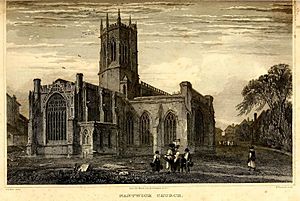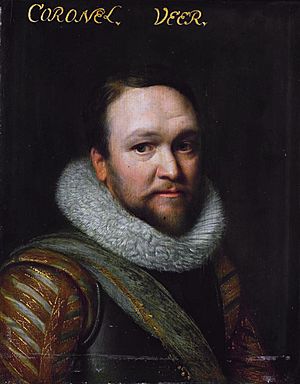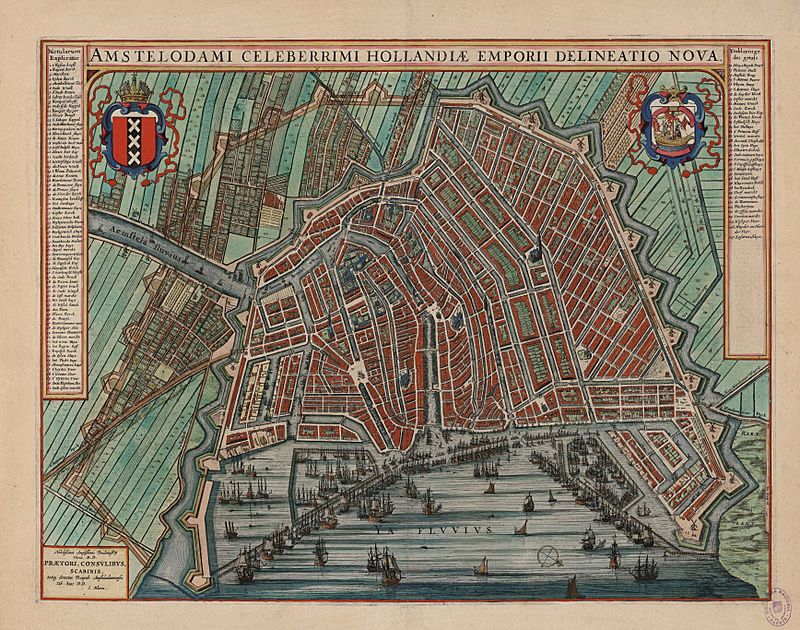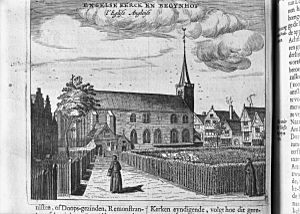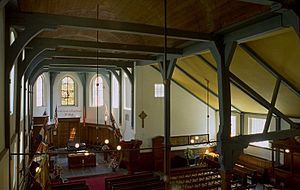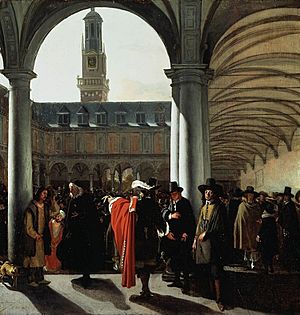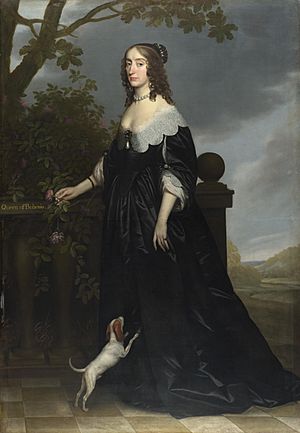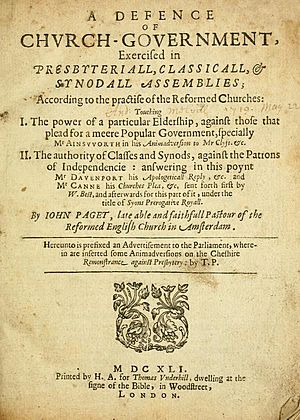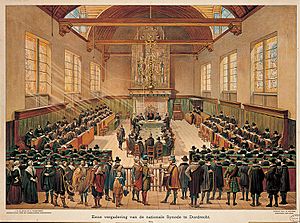John Paget (Puritan minister) facts for kids
Quick facts for kids John Paget |
|
| Born | c.1574 in Possibly Rothley, England |
|---|---|
| Died | 18 August 1638 in Amsterdam, Netherlands |
| Nationality | English |
| Church | Church of England, Dutch Reformed Church |
| Education | University of Cambridge |
| Writings | A Primary of the Christian Religion (1601) An arrovv against the separation of the Brownists (1618) Wisdomes Bountie to Heauenly Pilgrims (1622) Meditations of Death (1639) A Defence Of Church-Government, Exercised in Presbyteriall, Classicall, & Synodall Assemblies (1641) A Censure upon a Dialogue of the Anabaptists (1642). |
| Offices held | Rector of St Mary's Church, Nantwich Chaplain to English forces in the Netherlands Pastor of English Reformed Church, Amsterdam. |
| Spouse | Briget Masterson |
| Children | Childless. Adopted nephew, Robert Paget. |
John Paget (around 1574 – 18 August 1638) was an English clergyman who didn't follow the rules of the official Church of England. He later became a pastor at the English Reformed Church, Amsterdam. He was a strong supporter of Presbyterianism and a type of Protestant belief called Calvinism. He often debated with other English people living in the Dutch Republic who had different religious views.
Contents
Who Was John Paget?
John Paget likely came from the Paget family in Rothley, England. This village is in Leicestershire. He and his younger brother, Thomas Paget, were both Puritan ministers. They might have been born in Rothley or nearby. His nephew, Robert Paget, who John later adopted, said he was from Leicestershire. This suggests that John and Thomas had at least one brother who stayed in the area. The Paget family had a long history in Rothley.
John Paget's Education
John Paget started studying at Trinity College, Cambridge around 1592. He was a "sizar," meaning he received some financial help for his studies. This suggests he was born around 1574. He earned his first degree (Bachelor of Arts) in 1595 and his Master of Arts degree in 1598.
Early Career as a Clergyman
Rector of Nantwich
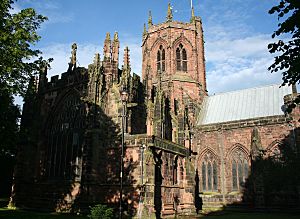
John Paget felt a strong desire to preach from a young age. By 1598, he was already appointed as the rector (a type of church leader) of Nantwich in Cheshire, England. In 1601, his first book was published. It was called A Primer of Christian Religion. In 1602, he married Briget Masterson, who was a widow.
Paget was a Puritan, which meant he wanted to "purify" the Church of England and make it simpler. When King James I became king, he tried to make everyone follow the Church of England's rules very strictly. Many Puritan clergy, including Paget, refused to obey these rules. Because of this, Paget had to leave Nantwich in 1605 and moved to the Netherlands.
Serving as a Military Chaplain
When Paget moved to the Netherlands, it was a war zone. The Dutch were fighting the Eighty Years' War to gain independence from Spain. For two years, Paget worked as a chaplain (a minister for soldiers) for English troops. These troops were fighting under leaders like Sir John Ogle and Sir Horace Vere. In 1605, the English troops fought in a major battle at Mülheim an der Ruhr. Paget likely had a very busy time helping and preaching to the soldiers during these difficult years.
Pastor of the English Reformed Church in Amsterdam
Becoming a Pastor
Paget's work as a chaplain was noticed. In 1607, the church leaders in Amsterdam asked him to be the minister of the new English Reformed Church. This church building used to belong to a group of religious women called the Beguines. The area where it stands is still called the Begijnhof.
Paget gave his first sermon on February 5, 1607. He spoke about "Make thou unto me a cleane heart O Lord" from the Bible. These words were later written on the church wall. He officially started his job on April 29.
Paget's church was different from other English groups in Amsterdam. Some groups wanted to completely separate from the Church of England. Paget wanted his church to be known as the "English Orthodoxicall church." He did not use the Book of Common Prayer (the official Anglican prayer book). Instead, he followed the Presbyterian polity, which meant the church was led by elders and ministers. His church was part of the Dutch Reformed Church, but it used the English language.
Growing Wealth
John Paget seemed to do well in his new role. He received a good salary from the Dutch church. His wife, Briget, joined him in Amsterdam, and they owned at least two houses. We know this because Briget sold them after Paget's death.
The Pagets also invested in the Dutch West India Company. This company was started in 1621 to challenge Spain's economic power. The Pagets' investment showed their support for this political and religious goal. The company had a very profitable year in 1629–30, giving a huge dividend after capturing a Spanish silver fleet. This was good for the Pagets, especially when John's brother, Thomas, and his family came to Amsterdam as refugees from England in 1631.
Friends and Connections
Even though Paget was involved in many debates, he had many important friends and connections. He got along well with English and Scottish leaders, especially when it came to supporting Protestants during the Thirty Years War. He was also friends with Elizabeth of Bohemia, a key figure in the European conflict. Briget Paget, his wife, was especially close to Elizabeth.
John Dury, a Scottish Protestant minister who worked to unite different Protestant groups, was another important friend. He even preached at Paget's church. Paget's interest in different languages and Jewish studies was well-known. His nephew, Robert, said John had "rare skill" in languages like Aramaic, Syriac, and Arabic. He used these skills to understand the original Bible texts.
Amsterdam had a large and growing Jewish community. Paget was part of a group of scholars who studied Jewish texts. However, he was careful about using Jewish interpretations. He believed that understanding Jewish sources could help argue against Judaism. This interest in Jewish studies was growing in Dutch universities, especially at Leiden University. Two of John Paget's nephews, Robert and Nathan, went to Leiden for their education.
Paget also kept in touch with people in England. Many English travelers visited him. One notable visitor was Sir William Brereton, 1st Baronet, who later became a military leader. He visited Paget in 1634 and enjoyed a meal with him.
Last Years and Death
John Paget continued his work until 1637, when he retired. He might have been ill at the time. He died about a month later, on August 18, 1638, near Amsterdam. His brother, Thomas Paget, then served the English Church in Amsterdam until he returned to England in 1646.
Family and What He Left Behind
| John Paget and his relatives | |||||||||||||||||||||||||||||||||||||||||||||||||||||||||||||||||||||||||||||||||||||||||||||||||||||||||||||||||||||||||||||||||||||||||||||||||||||||||||||||||||||||||||||||||||||||||||||||||||||||||||||||||||||||||||||||||||||||||||||||||||||||||||||||||||||||||||||||||||||||||||||||||||||||||||||||||||||||||||||||||||||||||||||||||||||||||||||||||||||||||||||||||||||||||||||||||||||||||||||||||||||||||||||||||||||||||||||||||||||||||||||||||||||||||||||||||
|---|---|---|---|---|---|---|---|---|---|---|---|---|---|---|---|---|---|---|---|---|---|---|---|---|---|---|---|---|---|---|---|---|---|---|---|---|---|---|---|---|---|---|---|---|---|---|---|---|---|---|---|---|---|---|---|---|---|---|---|---|---|---|---|---|---|---|---|---|---|---|---|---|---|---|---|---|---|---|---|---|---|---|---|---|---|---|---|---|---|---|---|---|---|---|---|---|---|---|---|---|---|---|---|---|---|---|---|---|---|---|---|---|---|---|---|---|---|---|---|---|---|---|---|---|---|---|---|---|---|---|---|---|---|---|---|---|---|---|---|---|---|---|---|---|---|---|---|---|---|---|---|---|---|---|---|---|---|---|---|---|---|---|---|---|---|---|---|---|---|---|---|---|---|---|---|---|---|---|---|---|---|---|---|---|---|---|---|---|---|---|---|---|---|---|---|---|---|---|---|---|---|---|---|---|---|---|---|---|---|---|---|---|---|---|---|---|---|---|---|---|---|---|---|---|---|---|---|---|---|---|---|---|---|---|---|---|---|---|---|---|---|---|---|---|---|---|---|---|---|---|---|---|---|---|---|---|---|---|---|---|---|---|---|---|---|---|---|---|---|---|---|---|---|---|---|---|---|---|---|---|---|---|---|---|---|---|---|---|---|---|---|---|---|---|---|---|---|---|---|---|---|---|---|---|---|---|---|---|---|---|---|---|---|---|---|---|---|---|---|---|---|---|---|---|---|---|---|---|---|---|---|---|---|---|---|---|---|---|---|---|---|---|---|---|---|---|---|---|---|---|---|---|---|---|---|---|---|---|---|---|---|---|---|---|---|---|---|---|---|---|---|---|---|---|---|---|---|---|---|---|---|---|---|---|---|---|---|---|---|---|---|---|---|---|---|---|---|---|---|---|---|---|---|---|---|---|---|---|---|---|---|---|---|---|---|---|---|---|---|---|---|---|---|---|---|---|---|---|---|---|---|---|---|---|---|---|---|---|---|---|---|---|---|---|---|---|---|---|---|---|---|---|---|---|---|---|---|---|---|---|---|---|---|---|---|
|
|||||||||||||||||||||||||||||||||||||||||||||||||||||||||||||||||||||||||||||||||||||||||||||||||||||||||||||||||||||||||||||||||||||||||||||||||||||||||||||||||||||||||||||||||||||||||||||||||||||||||||||||||||||||||||||||||||||||||||||||||||||||||||||||||||||||||||||||||||||||||||||||||||||||||||||||||||||||||||||||||||||||||||||||||||||||||||||||||||||||||||||||||||||||||||||||||||||||||||||||||||||||||||||||||||||||||||||||||||||||||||||||||||||||||||||||||
John Paget married Briget Thrush (born Masterson) on February 8, 1602. They did not have children of their own. However, they adopted Robert Paget, who was John's nephew. Robert later became a minister in Dordrecht. After John Paget died, Briget helped publish his writings. She moved to live with Robert. Together with Thomas and Nathan Paget, they helped share John's ideas with future generations of Puritans.
Briget and Robert first published John's book Meditations of Death in 1639. Briget wrote a special dedication for Elizabeth of Bohemia. Then, in 1641, they published John's Defence of Church-government. This book explained and defended the Presbyterian way of church leadership that he used in Amsterdam.
At this time, King Charles I was having problems in England, leading to the Bishops' Wars. Thomas Paget, John's brother, used John's book to support the Puritan cause in England. He presented his brother's book to Parliament. He explained how Presbyterianism was different from more extreme Puritan groups. He pointed out that the Netherlands found that Presbyterianism did not lead to chaos.
Thomas later returned to England to serve as a minister. Nathan Paget, John's nephew, became a doctor in London. He continued his uncle's interest in languages and Hebrew. He married Elizabeth Cromwell, a cousin of Oliver Cromwell, and became a close friend of John Milton, a famous writer. Nathan's career was not much affected when the monarchy was restored in 1660.
John Paget's Writings
John Paget wrote several books:
- A Primary of the Christian Religion (1601)
- An arrovv against the separation of the Brownists (1618)
- Wisdomes Bountie to Heauenly Pilgrims (1622)
- Meditations of Death (1639)
- A Defence Of Church-Government, Exercised in Presbyteriall, Classicall, & Synodall Assemblies (1641)
- A Censure upon a Dialogue of the Anabaptists (1642)
See also
- Dutch Golden Age
- History of the Calvinist–Arminian debate
- History of the Jews in Amsterdam


